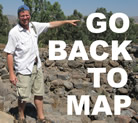In the Bible:
Num. 34:11, mountains on east shore were eastern boundary of the land of Israel;
Lk.5:4, first large catch of fish by disciples with Jesus;
Mt.8:1, Jesus heals leper;
Mk.4:35-41, Jesus calms storm; |

Lk.8:26-39, Demons drive pigs into Sea;
Jn.6:16, Jesus walks on water;
Mt. 18:1, better to tie a millstone around your neck;
Jn 21, Jesus meets disciples here after resurrection;
Jn. 21:6, second large catch of fish. |
The Sea of Galilee (Yam Kinneret) is a large lake 13 miles long; 7.5 miles wide in the north; 130-155 feet deep; 32 miles in circumference. The Sea receives 75% of its water from the Jordan River springs near Mt. Hermon in the north, but the rest comes from rainfall and springs. The climate is temperate year-round due to being 700 feet below sea level, the lowest fresh water lake on earth.
Average temperatures are 88 F. in late summer and 57 F. in January. Sudden and deadly storms, as recorded in the Gospels, are the result of the Sea of Galilee setting in a basin giving off warm air that combines with the colder air masses from the steep hills that surround the water. Sometimes the winds come over the hills on the west side, but the most deadly winds come from the east over the Golan Heights.
Eighteen species of fish are natural to the Sea, but there are up to thirty-five species living there today. Three types of fish are commonly recognized:
- Sardines, a daily food in NT. Seem to be the “two small fish” at feeding of the 5,000. Thousands of these are caught each night in modern times.
- Barbels or Catfish a scaleless and so unclean fish. May be the ‘bad’ fish Jesus referred to as being thrown aside in Matthew 13:48.
- Musht, or “St. Peter’s Fish,” can be as long as 18 inches. |


